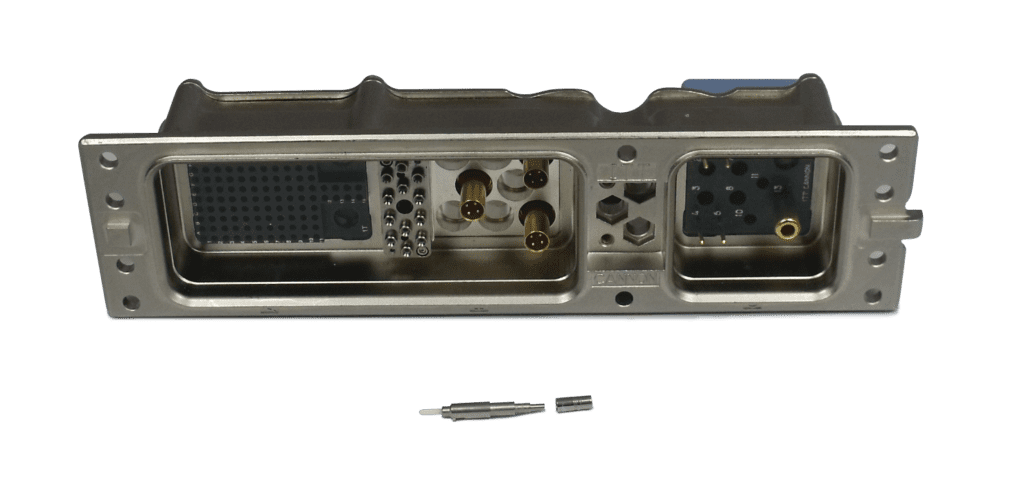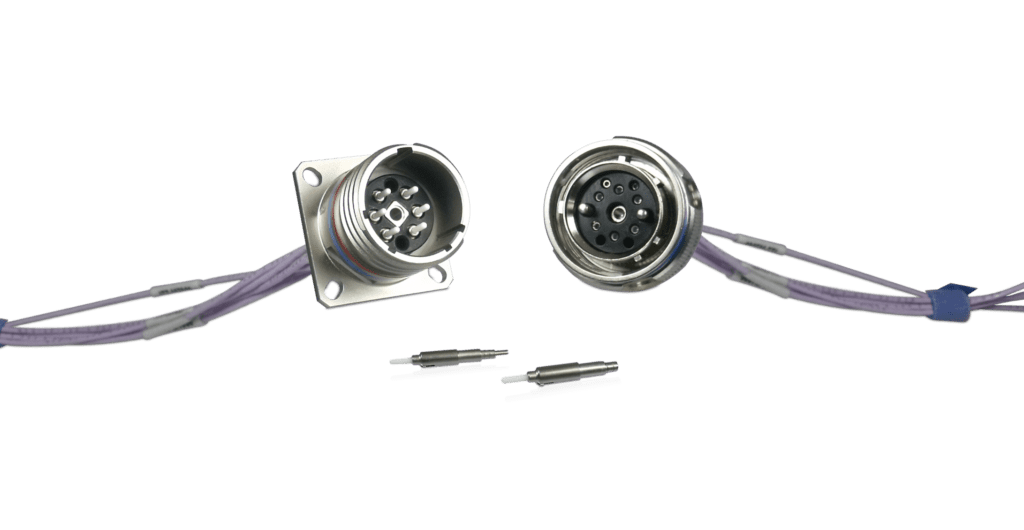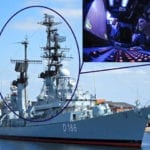The Connected Flight: Designing High-Speed Networks for Military and Commercial Aircraft
High-speed networks for military and commercial aircraft must handle ever-increasing data volumes at ever-faster speeds. Ethernet protocols, efficient network designs, and thoughtfully specified, high-quality connectors and cabling can help.
Wes Morgan, Product Manager, ITT Cannon
Addressing the Bandwidth Boom
Modern military and commercial aircraft are technology-rich environments designed to deliver an increasingly sophisticated set of features and capabilities. Packed with avionics, sensors, communications, and other data-trafficking systems, modern platforms depend on high-bandwidth networks to provide safe, comfortable travel for millions and to enable success in challenging military missions.
On modern commercial airliners, high-fidelity inflight entertainment and connectivity (IFEC) systems have dramatically increased bandwidth requirements. In addition to traditional seat-back entertainment consoles, travelers now expect (and even select airlines based on) emerging amenities like onboard Wi-Fi, streaming to personal devices, and even text and voice calling.
On military aircraft, missions and capabilities vary from platform to platform, but the rapid growth in the number of sensors and systems collecting and producing data require ever more powerful onboard networks. In recent years, the growth in the volume of data that many military aircraft collect, process, store, and transmit in the course of their missions has been exponential, and it’s expected to continue accelerating in the future.
Airborne onboard networks are largely built on the Ethernet Industrial Protocol (Ethernet/IP) thanks to its high performance, reliability, and universally accepted open standards. Ethernet class standards are evolving to support the aviation industry’s demand for higher speeds, but newer, faster connective methods for networks are needed as well. Consequently, interconnect solutions for both copper cable and optical fiber — the two primary cabling mediums used with Ethernet-based networks — are being re-engineered with additional contacts to address bandwidth and latency requirements.
New connector designs can support high speeds and low latency even as the volume of trafficked data grows. As new contact configurations are engineered, they are being designed to fit within existing, qualified connector body types, such as ARINC, and others, ensuring continuity with the most widely used standards and reducing the risk of form and fit issues when upgrading older systems.
The Ethernet Standard
Ethernet-based architectures are popular for several reasons. Benefits of this protocol include:
- High speeds of one Gigabit per second (Gbps) and above
- Unlimited network length and scalability
- Robustness and reliability through the use of established hardware components (e.g. switches, adaptors, and RJ-45 connectors)
- Increased network-wide system performance enabled by high-bandwidth connectors, including the Quadrax and ARINC standards and their various contact configurations

Figure 1: ITT Cannon’s rack and panel connector with ARINC 801 ASR delivers high-bandwidth performance ideal for use in demanding avionics Ethernet architectures.
Network Design: Where to Start
Network engineers should begin new commercial and military designs by asking themselves a series of questions, including:
- What are the performance requirements of the network with respect to transfer rate (Gbps)?
- What kinds of data will the network be channeling, and over what distance?
- How many nodes will the network have?
- What degree of packet loss are you willing to incur?
- How experienced with fiber and/or copper cabling are the maintenance personnel?
- What types of connectors are currently used on the platform? Can they support the required speeds?
- What type of environment will these connectors experience? Harsh, outside conditions or aircraft interiors?
In addition, military designers should ask themselves:
- What kind of environment the aircraft will be operating in with respect to: speed, vibration, shock, altitude, temperature extremes, sand, dust, and other conditions?
- Will the aircraft be exposed to high levels of electromagnetic interference, whether generated by onboard power systems, ambient radiation or hostile spectrum activity?
The answers to these questions will help engineers identify optimal networking equipment, including: the appropriate power supply, network adapters, cabling, switches, and access points, and will also help settle the critical choice of cabling medium and appropriate interconnects.
Connectors play a crucial role in the performance and fidelity of Ethernet networks, and are also essential for enabling network performance and ensuring compatibility with the two main cabling mediums: copper and optical fiber. Engineers and network integrators for both commercial and military platforms should understand that Ethernet/IP networks can be used in conjunction with twisted pair copper cable or optical fiber. Each has its own benefits and drawbacks, so the best solution for each individual application will be based on a multiple considerations.
Copper vs. Fiber
In general, copper is favored because it is widely available, affordable, capable of handling high-stress environments, and easy to maintain and service. However, copper’s drawbacks include weight, which can add up quickly (especially in big bundles), susceptibility to data loss over long distances, and vulnerability to electromagnetic interference (EMI).
By contrast, optical fiber is much lighter meter-for-meter, is capable of transmitting multiple data streams over a single fiber (vs. multiple copper wires), and — by virtue of using pulses of light rather than radio frequency signals — offers lossless data transmission over any distance. However, fiber is more fragile and more difficult and costly to maintain, requiring specialized technicians.
For commercial platforms, a key trend driving the evolution of aircraft materials and onboard systems is the need to reduce weight and improve fuel efficiency. From this standpoint, the weight-saving benefits of fiber are attractive, but designers should note that the serviceability challenges and their associated costs might offset these gains. Depending on network requirements and configuration, fiber may also make sense for long runs of cable as a backbone for a multi-node network, but shorter runs are likely better served by copper.
For military aircraft, much depends on the platform and its mission. However, when weight is a critical factor, like in unmanned systems and rotary platforms, fiber presents an obvious advantage. This is equally true on platforms where space is at a premium and/or aircraft topology requires that sensors and processing electronics be located in different places, but without sacrificing the integrity of the transmitted signal. Fiber’s resistance to EMI is a considerable benefit for military platforms operating in a contested and congested electromagnetic spectrum as well. Although, copper’s ruggedness is often better suited to the harsh shock and vibration extremes of military aircraft.
Connector Considerations
Specialized connectors exist to provide interconnects for both twisted pair copper cable and optical fiber networks. While there is no formal standard for connection within most modern aircraft control systems, ARINC 600 and 38999-style Series III connectors are most commonly used in commercial aircraft applications.

Figure 2: ITT Cannon’s D38999-Style Series III connectors with ARINC 801 fiber optic inserts are ideal for use in a wide range of commercial aircraft applications.
On military platforms, 38999-style Class G space-grade connectors are popular, as are PHD and tight-tolerance D38999-style fiber optic connectors, which are capable of exceptional performance on even supersonic platforms that experience significant stress.
Summary
As markets, applications, and network requirements continue to evolve and aircraft systems’ dependency on enormous volumes of data continues to grow, engineers and integrators will be continuously challenged to think about how to deal with what’s new and what’s next. When considering the best way to design onboard networks for commercial and military platforms, choosing the right networking equipment and channeling medium (i.e., copper cable or optical fiber) is critical to the network’s performance, and ultimately to the experience of commercial airline passengers or the success of high-stakes military missions. Each approach has its own benefits and drawbacks, but if designers assess expectations early and ask the right questions, they are sure to arrive at the best possible solution.






